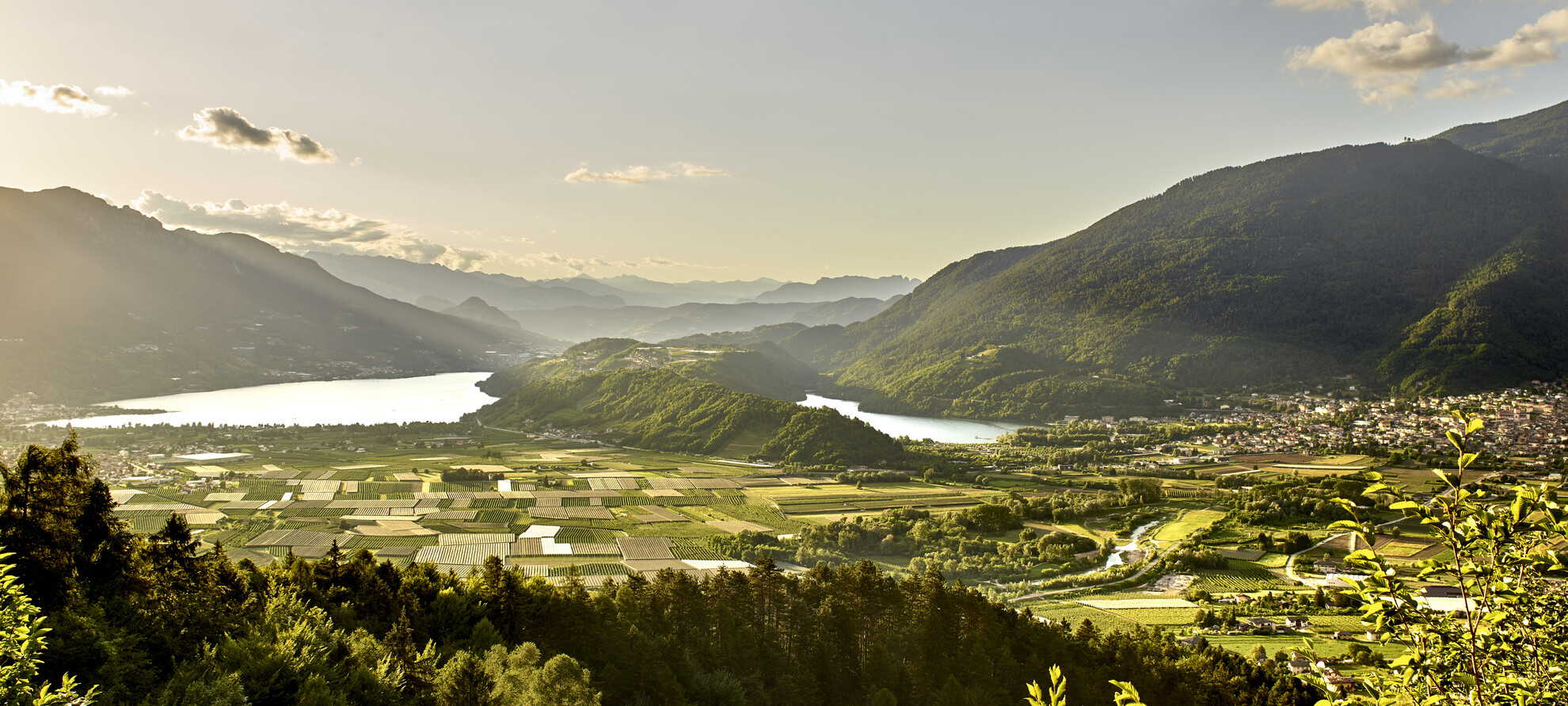Valsugana and Lagorai: the sixth section of the Path of Peace
From Altopiano di Vezzena to Cimon della Pala, crossing the wild and remote Lagorai
The sixth section of the Sentiero della Pace, comprising 7 stages and extending for more than 120 km, is an undulating route that climbs from the Blue Flag lakes of the Valsugana to the Dolomitic peaks of Pale di San Martino. In between, the route takes you through the wild and ever-changing Lagorai, whose granite rocks, green pastures and glacial lakes are sure to leave their mark on your memory.
It is a rather unusual route, which at times deviates significantly from the traditional itinerary of the Path of Peace. Please study the proposed itinerary carefully before setting out!
Before setting off, please read the Safety in the Mountains guidance and contact the rifugios in advance to ensure that they are open and have availability for overnight stays.
Once this is taken care of, it's time to put on your boots and start walking.

STAGE 1: From Passo Vezzena to Caldonazzo
This fairly easy stage leads down from the plateau to reach Valsugana on the shores of Lake Caldonazzo, the largest lake in the Trentino region and a popular destination for water sports enthusiasts.
At Monterovere you can take a short break to admire the remains of theAvez del Prinzep, a majestic silver fir tree that was broken after a very violent storm in November 2017 and which, until that moment, had boasted the record of being the tallest tree of its kind in Europe.
Not far from the start of the stage there is also the vast Austro-Hungarian military cemetery of Slaghenaufi as well as the ruins of what was once one of the region's four large field hospitals, the Malga Belem, which was very modern and well-equipped for the time.
The walk ends at the warm waters of Lake Caldonazzo, where you can take a dip or try your hand at one of the many water sports available: scuba diving, sailing, windsurfing, kitesurfing, water skiing and rowing.
And if you're here towards the end of August, you may even see Dragons parading on the waters of the lake! The Palio dei Draghi event takes place every day, a sporting event that since 1993 has seen many dragon boats - long canoes decorated with dragon heads - compete in speed races.
STAGE 2: From Caldonazzo to Vetriolo Terme
After a relaxing break on the shores of Lake Caldonazzo, it's time to get back on the trail and tackle a rather significant ascent, climbing 1,500 metres along the northern slope of the Valsugana and passing Lake Levico, the Tenna and Benne forts, and finally the thermal spa of Vetriolo.
The Canneto del Lago di Levico deserves a special mention: this unique protected biotope is home to numerous populations of submerged and floating plants including marsh reeds, water lilies and deciduous (broad-leaved) trees.
At an altitude of 1,600 metres, in the hamlet of Vetriolo, the highest thermal spa in Europe, the Lupa del Lagorai stands proudly facing the sky. The she-wolf sculpture, a work by sculptor Marco Martalar, is 6 metres high and was crafted from about 2,000 wood fragments left behind by Storm Vaia. If you have time, it certainly deserves a look.
Walking along the roads and paths of the Valsugana, it will soon become apparent the region is deeply imbued with culture and history. For example, the Lagorai and Ortigara mountains are linked to the stories written by several soldier-writers and poets such as Robert Musil (1880-1942) and Emilio Lussu (1890-1975), who artfully and originally translated their personal experiences of war into prose.

STAGE 3: From Vetriolo Terme to Campestrini
This is a long but easy route with a limited overall height difference, most of it downhill, which develops pleasantly over straightforward terrain with remarkable views of the Adamello, Brenta and Austrian peaks.
The surrounding landscape at the start of the walk is striking for its wide open spaces, in contrast to the much denser ones previously encountered at the same altitudes.
On arrival, you are welcomed by the pleasant hamlet of Campestrini, where several monumental chestnut trees of deep cultural value have survived for five centuries, so much so that they appear among the 4003 entries in the “List of Monumental Trees of Italy”.
STAGE 4: From Campestrini to Rifugio Conseria
A long but relatively fast stage towards the Lagorai and Cima d'Asta, starting from Campestrini and leading in little more than twenty kilometres to Malga Conseria, overlooking the lush and verdant Val Campelle and its pastures and streams.
A word of advice: before leaving Campestrini, visit the nearby Monte Ciolino, a low, rounded promontory on which stand the ruins of Castel San Pietro, also known as Castel Tre Corni because of the solitary trio of medieval walls that have survived to this day. During the Great War, Monte Ciolino was entrenched and many tunnels were dug here, some of which can still be explored via a thematic trail.
The route then continues to Rifugio Carlettini. From here, take the Sentiero dell'Acqua (Water Path) which runs parallel to the Rio Maso Spinelle stream, before the tone of the walk undergoes a sudden and sharp change: a beautiful ascent which, with a significant but constant gradient, takes you to the meadows of Malga Conseria.

STAGE 5: From Rifugio Conseria to Rifugio Brentari
The stage described here deviates from the original Path of Peace which from Malga Conseria continues at lower altitudes to Rifugio Refavaie. The variant shown here follows the Sentiero Italia and then (from Forcella Magna) the Alta Via del Granito.
This is an utterly spectacular stage! Ascend just above the rifugio to reach the Cinque Croci pass in a few minutes. From here there is a wonderful view of Cima d'Asta, Cima delle Stellune, the Cauriol and the Pale di San Martino.
Near Rifugio Conseria it is also possible to take a short detour to Laso delle Buse, which for centuries has provided an important resting place for hunter-gatherers and is now the starting point of the Mesotrekking, a 4-stage thematic long distance hiking route that extends for 46 km and was developed 40 years ago by Trentino writer Tullio Pasquali.
Along the way, it is possible to admire the thirty or so beautiful and circular glacial lakes dotted amid the meadows between Passo Cinque Croci and the summit of Cima d'Asta.
Please Note: At the end of the stage, if you still have enough energy and enthusiasm you can continue the ascent to the summit of Cima d'Asta (2846 metres), where you will be rewarded by an extraordinary panorama of all the main Dolomite groups, from Catinaccio and Marmolada to Latemar and Civetta. The return journey retraces the route back to Rifugio Brentari.
STAGE 6: From Rifugio Brentari to Caoria
The stage described here deviates from the original Path of Peace which from Rifugio Refavaie follows the road to Caoria. The variant shown here follows a section of the Sentiero Italia.
Although short and almost entirely downhill, this non-trivial stage (classified EE) offers an opportunity to explore Val Regana which, protected by beautiful dense forests and rocky walls, remains a rarely visited and wild hidden gem.
After the descent from Sentiero Negrelli, undoubtedly the most challenging section of the route, it is worth spending some time looking closely at the tall grass around you: you might catch a glimpse of the small glistening shell of the leaf beetle Oreina cacaliae, which is very common in this area.
The stage ends in Caoria, home to the diverse Ecomuseum del Vanoi, a museum designed to embrace open space which explores some of the sites crucial to traditional culture. Its diverse sites include the Ethnographic Trail and the small but comprehensive Museum of the Great War which houses a wide collection of wartime and everyday artefacts from the period.

STAGE 7: From Caoria to Capanna Cervino
The route between Passo Colbricon and Passo Rolle is an additional stage to the original Path of Peace (which continues to Paneveggio) and is suggested here in order to break up the otherwise long stretch at the nearby Passo Rolle. If you prefer to continue on to Paneveggio, from the pass you should allow at least three hours additional walking time.
A fairly long stage at around 22 km, mostly uphill, which opens the doors to the incredible Pale di San Martino.
The first part of the route takes you along the Ethnographic Trail and, if time allows, we recommend a visit to the water-powered sawmill, the Siega de Valzanca. As you continue, the forest soon begins to thin out and gives way to broad open pastures, with the first dolomite spires beginning to emerge above. Finally you reach the Malga Tognola in Siror, at 1986 m, from where you can admire the Pale di San Martino in all their splendour!
A bit of trivia: The end point of this stage, Rifugio Capanna Cervino, takes its name from the moniker the Irish mountaineer and naturalist John Ball gave to the Cimon della Pala in 1864: noting the verticality of its cliff, he dubbed it “the Matterhorn of the Dolomites” (Cervino being the Italian name for the Matterhorn) because of its resemblance to the imposing four-thousand-metre peak of the Pennine Alps. Did you know?
The stage may be complete, but at sunset we highly recommend you visit Baita Segantini, an exceptional spot to enjoy the enrosadira - that special phenomenon where the rocks blaze pink in the fading light - over the shark fin of the Cimon della Pala.

Discover all the stages of the Path of Peace
go


